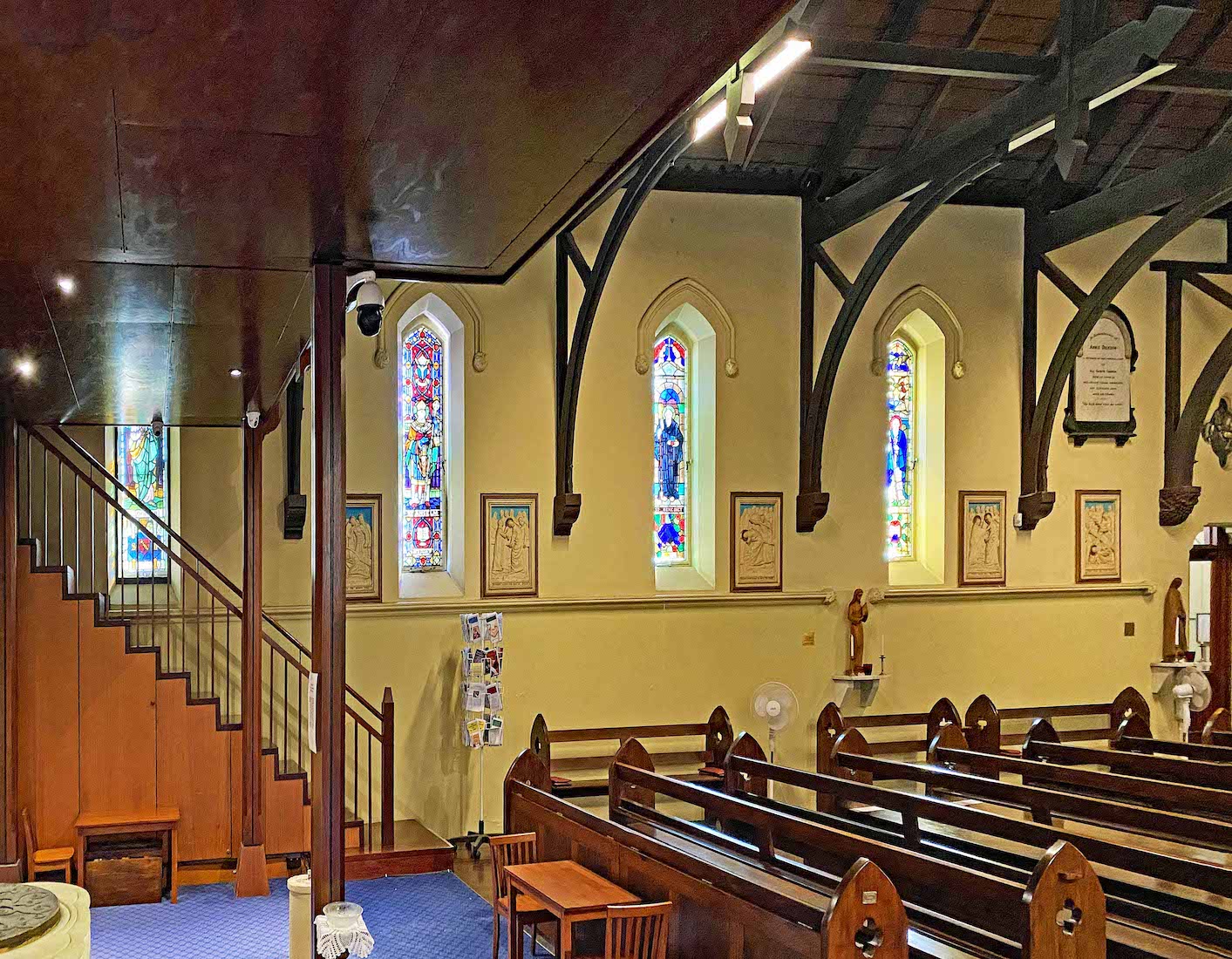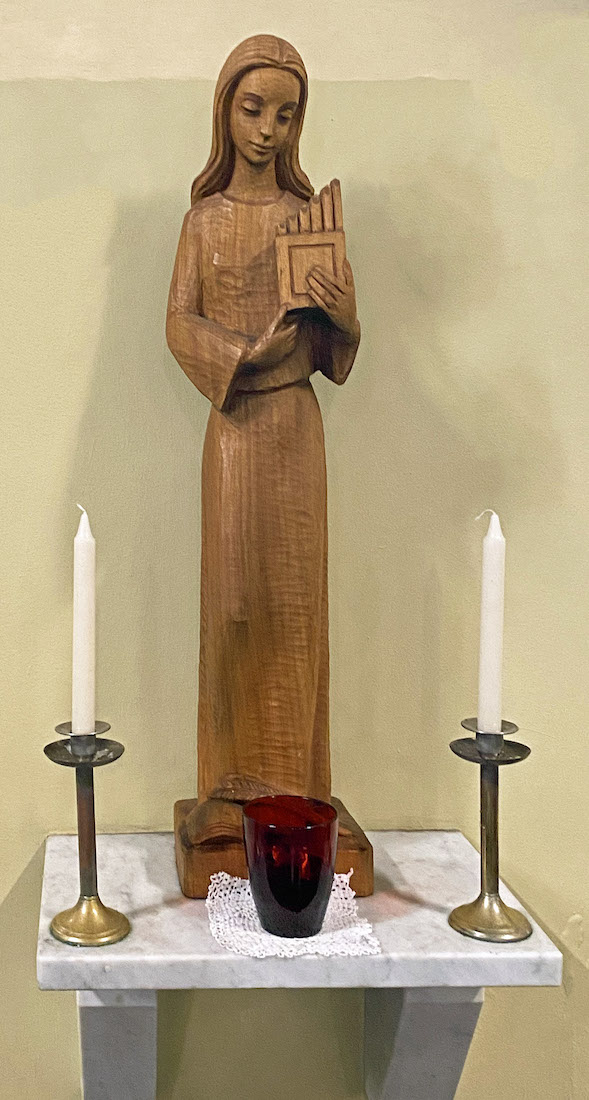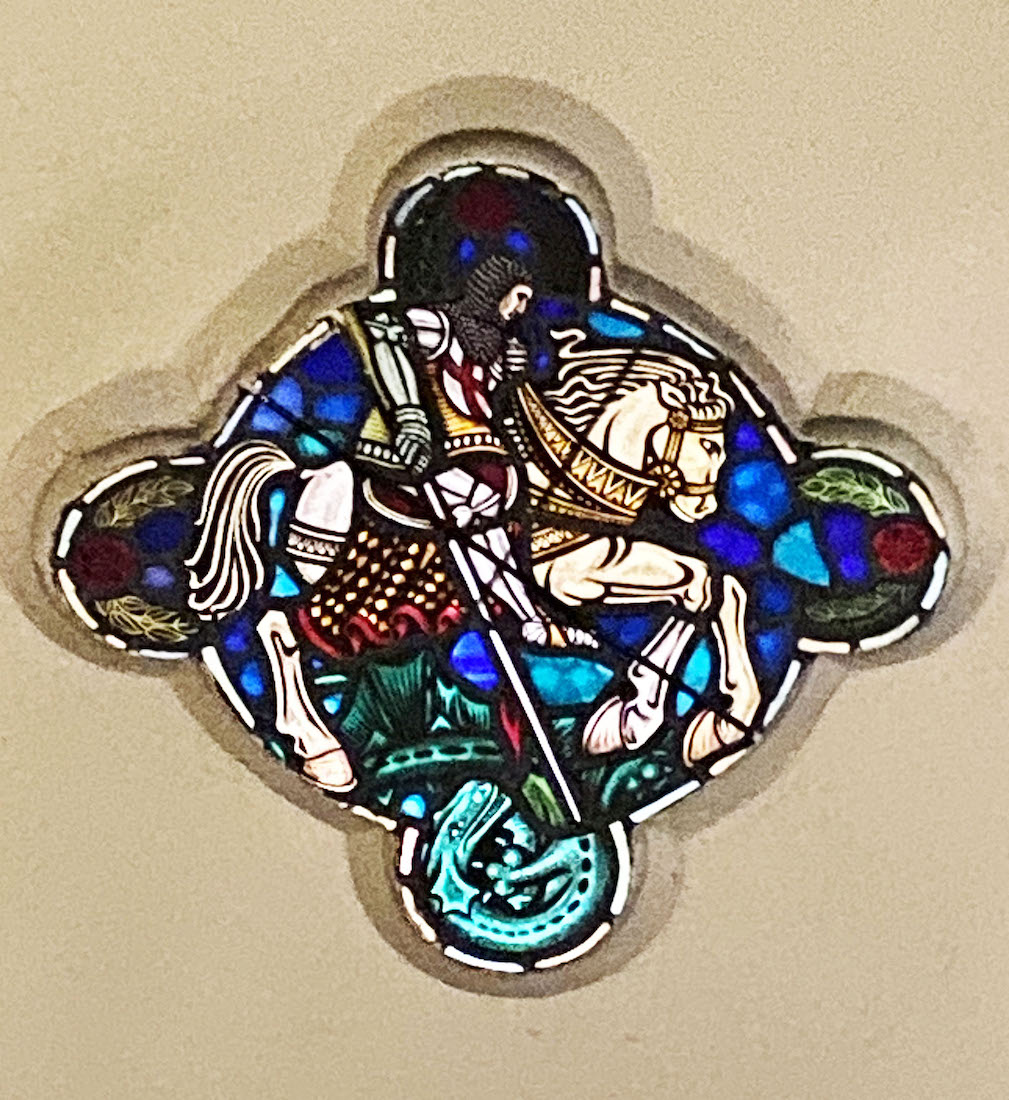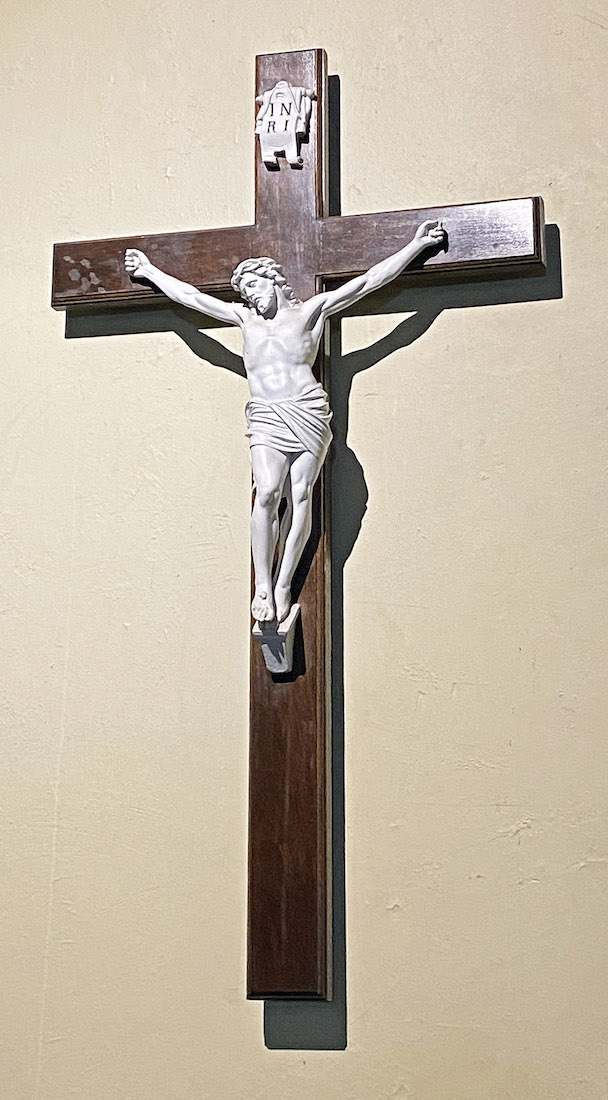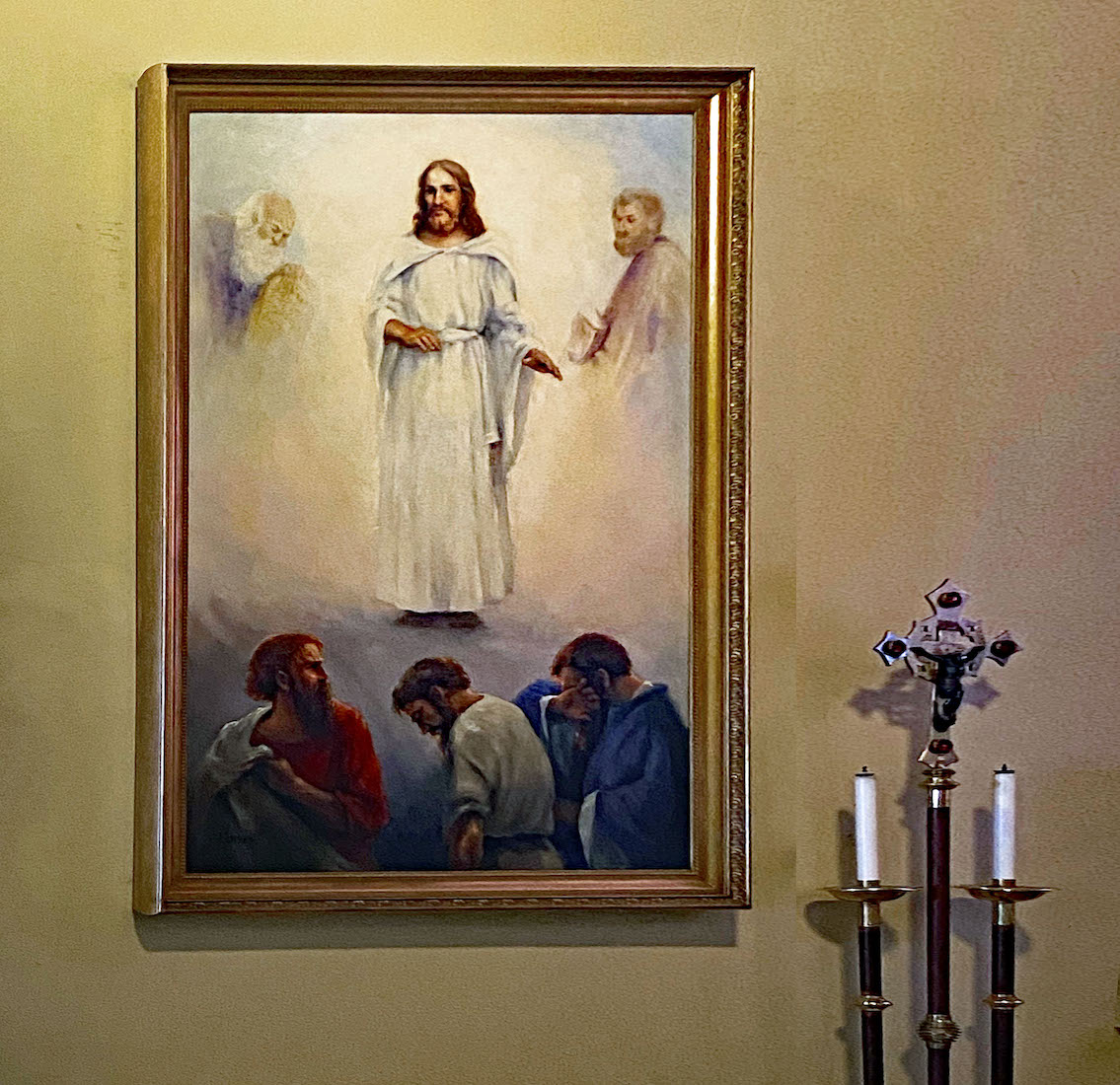
We now look beneath the balcony. There is an entry door into the Church on either side, each with a semi-circular window above. At centre is the baptismal font and the Paschal candle. Left of the font is a display relating to Our Lady of Walsingham. And right of the font is a shrine to St Theresa of Ávila. INDEX
22. ABOVE THE WEST DOORS


We first look at the windows above the entry doors. ••• The window above the South (left) door is dedicated to the New Guinea Martyrs. These were 12 people who were serving the Anglican church in Papua and New Guinea when the events of Second World War, and particularly the Japanese invasion of PNG, impacted them. They were teachers, nurses, priests, lay-workers and evangelists. Most were either Australian or English but two were Papuans. These 12 are called martyrs because they were killed in the course of their mission service either by Japanese forces or local Papua New Guineans in 1942 and 1943. ••• The window above the North door remembers Maximilian Kolbe. He was a Polish Catholic priest and Conventual Franciscan friar who volunteered to die in place of a man named Franciszek Gajowniczek in the German death camp of Auschwitz, located in German-occupied Poland during World War II. He had been active in promoting the veneration of the Immaculate Virgin Mary, and founding and supervising the monastery of Niepokalanów near Warsaw.
23. WALSINGHAM SHRINE
Our Lady of Walsingham is a title of Mary, mother of Jesus venerated by Catholics, Western Rite Orthodox Christians, and High Church Anglicans. The name is associated with the Marian apparitions to Richeldis de Faverches, a pious English noblewoman, in 1061 in the village of Walsingham in Norfolk, England. Lady Richeldis had a structure built named ‘The Holy House’ in Walsingham which later became a shrine and place of pilgrimage.
24. BAPTISMAL FONT
At centre under the balcony stands a baptismal font. Baptism is regarded as an initiation rite into the Church and indeed into a personal fellowship with Christ. The font is often placed near the Church entry in a symbolic way. ••• The Paschal candle is a special candle lit over the Easter period as a reminder that Jesus is the Light of the world.
25. ST TERESA PAINTING
To the right of the font is a shrine to Teresa of Ávila, OCD (1515 – 1582). She was a Carmelite nun and prominent Spanish mystic and religious reformer. Active during the Counter-Reformation, Teresa became the central figure of a movement of spiritual and monastic renewal, reforming the Carmelite Orders of both women and men. The movement was later joined by the younger Carmelite friar and mystic John of the Cross, with whom she established the Discalced Carmelites.
26. NORTH WALL WEST
We leave the shelter of the balcony (!) to explore the North nave wall. Stained glass windows, memorials, Stations of the Cross, and small statues await us.
27. NORTH NAVE WINDOWS
The windows along this wall depict various Christian saints. Fortunately, each window has the name of the pictured saint. So from left, the windows show: St Monica, St Anselm, St Benedict, and St Ignatius of Antioch. St Monica ( c. 332 – 387) was an early North African Christian saint and the mother of Augustine of Hippo. St Anselm of Canterbury has been called ‘the most luminous and penetrating intellect between St Augustine and St Thomas Aquinas’ and ‘the father of scholasticism’. St Benedict of Nursia OSB was an Italian Christian monk, writer, and theologian who is venerated in many branches of the Christian Church. His main achievement, his Rule of Saint Benedict, contains a set of rules for his monks to follow. St Ignatius of Antioch (died c. 140 AD?), was an early Christian writer and Patriarch of Antioch. While en route to Rome, where he met his martyrdom, Ignatius wrote a series of significant letters. He is considered to be one of the three most important of theApostolic Fathers, together with Clement of Rome and Polycarp.
28. NORTH WALL EAST
This brings us to the North door, but there are further items of interest beyond the door.
29. MORE NAVE WINDOWS
The three further windows depict St Agnes, St Luke and St John. St Agnes is a martyr from the early Church in Rome. Though she was only a young girl when she faced death, her devotion to her faith is an example to all of us. ••• St Luke, or Luke the Evangelist, is one of the Four Evangelists – the four traditionally ascribed authors of the canonical gospels. The Early Church Fathers ascribed to him authorship of both the Gospel of Luke and the Acts of the Apostles. His symbol is the ox. ••• St. John the Evangelist, also called Saint John the Divine, was one of the Twelve Apostles of Jesus and is traditionally believed to be the author of the three Letters of John, the Fourth Gospel, and possibly the Revelation to John in the New Testament. He played a leading role in the early church at Jerusalem. His symbol is the eagle.
30. STATIONS OF THE CROSS
The 14 bas-relief Stations of the Cross were made by Daphne Mayo and installed in 1935. All the Stations of the Cross at All Saints Church can be viewed here. Stations of the Cross depict the journey Jesus made to be crucified. They are used as an aid to meditation, particularly at Easter time.
31. SAINTS
There are three wooden statues of saints along this wall. From left to right: ••• Perhaps St Cecilia, patron saint of music. Saint Cecilia was a Roman virgin martyr and is venerated in many traditions. She became the patroness of music and musicians, it being written that, as the musicians played at her wedding, Cecilia ‘sang in her heart to the Lord’. ••• St Clare of Assisi (1194 – 1253) was an Italian saint and one of the first followers of Francis of Assisi. Inspired by the teachings of St. Francis, she founded the Order of Poor Ladies, a monastic religious order for women in the Franciscan tradition. ••• St Francis of Assisi was an Italian mystic and Catholic friar who founded the Franciscans. He was inspired to lead a life of poverty as an itinerant preacher. He is one of the most venerated figures in Christianity.
32. MEMORIALS BY THE NORTH DOOR
High on the wall by the North door are memorials to Sir James Robert Dickson, and to his wife Annie. James was the First Minister of Defence for the Commonwealth of Australia. He married Annie Ely in 1855. It is said (rather sadly) of Annie: ‘She hath done what she could.’ It might be added that she bore 15 children in the space of 21 years! ••• Lower on the wall is a brass plaque relating to the wooden statues of Clare and Francis of Assisi.
33A. TRANSEPT WINDOWS
The first view of the sanctuary end of the Church shows the location of the two high transept windows, as well as a small window on the left side of the sanctuary. The transept windows form an interesting pair. The central discs show the Cross (with a diagonal ladder) and the empty tomb. The ladder is a reference to ‘Jacob’s ladder’, and we shall see a reappearance of this shortly. The surrounding disks appear to show angels holding Elements of the Eucharist: wine at left and bread at right. These windows, and the corresponding change in roofline, are the only interior indication of the existence of Church transepts. [First photo credit: all saints walkinto]
33B. TWO OTHER SMALL WINDOWS
There are two other small windows in the Northeast corner of the nave. ••• Above the North door is a curiously shaped window depicting St George slaying the dragon. St George gains a lot of publicity from this legendary feat! ••• The second little window on the wall North of the sanctuary is a clever interpretation of the Nativity, showing the star and a descending dove.
34. ST JOSEPH
East of the North door, and below the windows, is this statue – presumably Joseph – a carpenter with mallet and set-square. Joseph had an important part to play in the raising of the young Jesus, and is ofter overlooked.
35. BANNERS
Banners have an important part to play in the life of a High Church, appearing in many ecclesiastical processions. Shown here are the Mothers’ Union banner, a banner celebrating the Eucharist, and a banner carrying the text: ‘All ye Holy Saints of God, Intercede for Sinners’.
36. CROZIER
The bishop’s crook is symbolic of the bishop’s care for his flock, in the same way that a shepherd has care for his sheep. The bishop’s crook is also called a crozier, and the nearby notice points out the significance of this particular crozier to the All Saints Church. ••• Just to the right of the crozier is a door through to the vestry.
37. PULPIT AND CRUCIFIIX
The simple pulpit carries the words of James 1:22 : ‘Be doers of The Word, and not hearers only.’ Below is a small quatrefoil with the letters IHS – Greek letters for the first three letters of the name ‘JESUS’. A crucifix on the wall bears the traditional letters: INRI – Jesus of Nazareth, King of the Jews.
38. SANCTUARY
This brings us to the sanctuary recess – not accessible to the public, but shallow enough to see all the details. The door at left leads through to the vestry. Above hangs the sanctuary lamp. And around the archway are written the famous words of Jacob after he had viewed the ladder up to heaven: ‘This is none other but the House of God, and this is the gate of Heaven.’ (Genesis 28:17)
39. SANCTUARY LAMP
The sanctuary lamp has different meanings in different traditions. A central lamp like this in an Anglican church stays alight at all times, and indicates the presence of God. A more restrictive use is where a lamp is placed by an aumbry or tabernacle, indicating the presence of Blessed Elements of the Eucharist. A not dissimilar meaning ... .
40. TRANSFIGURATION AND PROCESSIONAL CROSS
On the North wall of the sanctuary is a painting of Christ and the disciples James, Peter and John on the Mount of Transfiguration. Jesus is pictured with Moses and Elijah, representing the Law and the prophets in the Old Testament. For the three disciples this was a significant spiritual experience: the painting is well placed! ••• Next to the painting is a processional cross with a small crucified Christ and two candles. Beyond this is a small cupboard – perhaps an aumbry.







